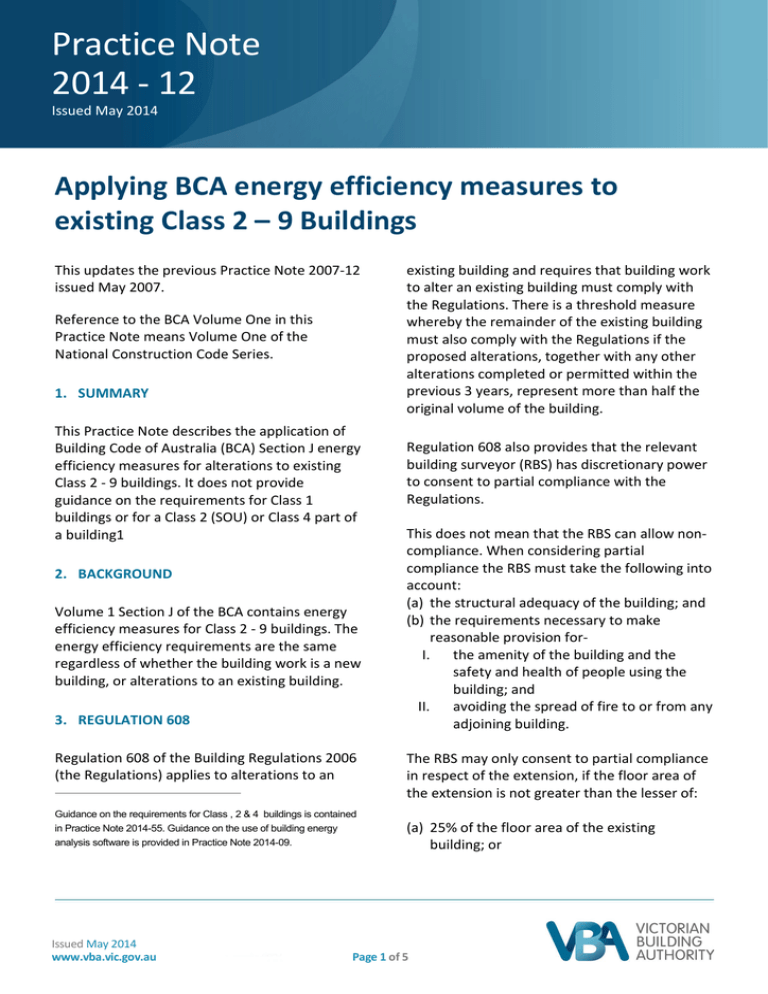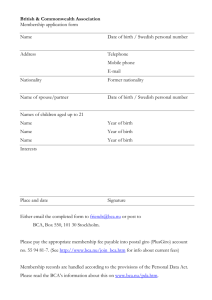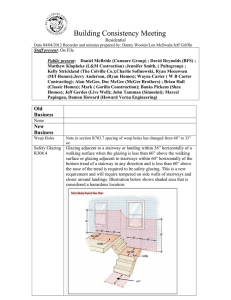PN-12-2014-Applying BCA energy efficiency
advertisement

Practice Note 2014 - 12 Issued May 2014 Applying BCA energy efficiency measures to existing Class 2 – 9 Buildings This updates the previous Practice Note 2007-12 issued May 2007. Reference to the BCA Volume One in this Practice Note means Volume One of the National Construction Code Series. 1. SUMMARY This Practice Note describes the application of Building Code of Australia (BCA) Section J energy efficiency measures for alterations to existing Class 2 - 9 buildings. It does not provide guidance on the requirements for Class 1 buildings or for a Class 2 (SOU) or Class 4 part of a building1 2. BACKGROUND Volume 1 Section J of the BCA contains energy efficiency measures for Class 2 - 9 buildings. The energy efficiency requirements are the same regardless of whether the building work is a new building, or alterations to an existing building. 3. REGULATION 608 Regulation 608 of the Building Regulations 2006 (the Regulations) applies to alterations to an Guidance on the requirements for Class , 2 & 4 buildings is contained in Practice Note 2014-55. Guidance on the use of building energy analysis software is provided in Practice Note 2014-09. Issued May 2014 www.vba.vic.gov.au existing building and requires that building work to alter an existing building must comply with the Regulations. There is a threshold measure whereby the remainder of the existing building must also comply with the Regulations if the proposed alterations, together with any other alterations completed or permitted within the previous 3 years, represent more than half the original volume of the building. Regulation 608 also provides that the relevant building surveyor (RBS) has discretionary power to consent to partial compliance with the Regulations. This does not mean that the RBS can allow noncompliance. When considering partial compliance the RBS must take the following into account: (a) the structural adequacy of the building; and (b) the requirements necessary to make reasonable provision forI. the amenity of the building and the safety and health of people using the building; and II. avoiding the spread of fire to or from any adjoining building. The RBS may only consent to partial compliance in respect of the extension, if the floor area of the extension is not greater than the lesser of: (a) 25% of the floor area of the existing building; or Page 1 of 5 Practice Note 2014-12 (b) 1000m2. 4. DEEMED-TO-SATISFY PROVISIONS Section 28 of the Building Act 1993 and Regulations 502, 503, 609 and 1011 provide the RBS with other discretionary powers related to partial compliance. 3.1 REGULATION 608 - WHAT IS REASONABLE? When deciding whether to permit partial compliance under regulation 608, the RBS should consider how reasonable full compliance would be in a particular instance, along with the likely cost and benefit. The Macquarie Dictionary defines “reasonable” as “agreeable to reason or sound judgment”. The RBS should apply their own judgment (using their qualifications and experience) to the specific matters being assessed. In some instances the RBS will need to seek the advice of other suitably qualified practitioners or industry experts in determining the acceptability or otherwise of a specific building, element of construction or use The energy efficiency provisions have been developed on a basis of saving energy and longterm cost effectiveness for the building owner. On the same basis, when determining whether a dispensation from the energy efficiency provisions should be granted, it may be reasonable to ask "Is it cost effective?" Guidance on the economic criteria used in developing the BCA energy efficiency provisions can be found in the report titled, "Financial Analysis Procedure for Energy Efficiency in Buildings, Classes 2-9" by the Atech Group (2003). This report is available from the Australian Building Codes Board website (http://www.abcb.gov.au). While the economic criteria used in this report may change, the basic principles for determining long-term cost effectiveness remain the same. Issued May 2014 www.vba.vic.gov.au It is not possible to address all potential situations involving existing buildings however, the basic principle is that where possible and practicable, any new building -work should comply with the BCA energy efficiency provisions. For guidance the ABCB has produced a number of handbooks dealing with energy efficiency for Class 2- 9 Buildings and applying Section J these are available from its website. 4.1 Building fabric Where a building is being extended, the fabric of the extension should fully comply with the BCA fabric provisions. Partial compliance may be considered where the extension is relatively small. Where the new work includes replacement of existing elements, such as roof cladding, wall cladding or wall lining, compliance with the BCA fabric provisions should be achieved. However, if the roof cladding, wall cladding or wall lining is only being repaired, then it may be unreasonable to require this to be removed, solely to install new insulation. Example An existing office building between a main street and a lane is being extended to the adjoining allotment. For aesthetic reasons, the existing facade is being replaced. The fabric of the extension needs to comply with the BCA fabric provisions. Because the facade is being replaced, it is reasonable to expect that insulation can be added to that external wall of the existing building. However, as work is not being carried out on the rear wall of the existing building (other than painting), requiring that wall to be insulated is not considered “reasonable”. Page 2 of 5 Practice Note 2014-12 4.2 EXTERNAL GLAZING Where an existing building is being extended, the glazing in the extension should comply with the BCA glazing provisions. However, this is complicated by the fact that the glazing provisions are determined on the basis of either a whole storey (for Glazing Method 1), or for each facade in each storey (for Glazing Method 2). This means that the existing glazing also needs to be considered. In some cases it may be unreasonable for new glazing in an extension to compensate for the poor performance of existing glazing. In this instance it would be reasonable to determine compliance by applying the performance of the new glazing uniformly to the whole storey (for Glazing Method 1), or just the façade (for Glazing Method 2), but only require the complying glazing to be installed in the extension. If all the existing glazing in a building is being replaced, then the new glazing should comply with the current BCA glazing provisions. Shade is integral to glazing performance. However, there may be site constraints or planning requirements that prevent external shading being added to an existing building. In such instances the required performance level may be achieved by unshaded glazing, but only by using unreasonably costly materials. It would therefore be “reasonable” to allow a reduced level of glazing performance where such constraints on shading exist. Example A restaurant with a floor area of 470 m2 is situated between two other buildings, a main street and a rear lane. It is to be refurbished, with new and larger glazing installed facing the main street. This new glazing should comply with the provisions. The glazing for a Class 6 building can be assessed using either Glazing Method 1 or Glazing Method 2. Glazing Method 1 is based on an allowance per storey. As the glazing away from the main street is unlikely to be upgraded, the aggregate performance of the glazing using Glazing Method 1 must be based on the performance of the existing glazing facing the lane, in conjunction with the new glazing facing the main street. However, if Glazing Method 2 is used, then only the new glazing facing the main street is considered, as this method is based on an allowance for each façade of each storey. 4.3 BUILDING SEALING An extension of one or more new rooms should be sealed in accordance with the BCA sealing provisions. If an existing room is being extended, the need for sealing may depend upon its condition. Sealing of an existing room is an all-or-nothing matter. If the existing building is not sealed and has large areas of unsealed louvred glazing for example, then there is little benefit in sealing the new part. In the case of a new extension to an existing unsealed building, a practical approach may be to accommodate the different amounts of sealing in the new and existing parts of the building, by installing sealed doors between the two parts. The final decision should be based on the relative size of the extension and the extent to which the existing part is unsealed. 4.4 AIR-CONDITIONING AND VENTILATING SYSTEMS Air-conditioning and ventilating systems may be new systems that are installed in a building, or in a new extension. They may be partly new and partly existing systems, within an altered existing building. The BCA provisions may also apply where the air-conditioning system is being replaced with a Issued May 2014 www.vba.vic.gov.au Page 3 of 5 Practice Note 2014-12 new and upgraded system in an existing building. Example 1 The air distribution elements of an existing airconditioning system are being modified, as part of a general refurbishment. Some of the existing uninsulated ductwork is being repositioned and some is being replaced. New systems and elements in new parts of a building and new elements and systems in existing parts of a building should all comply with the BCA services provisions. Ideally, all ductwork in the area being refurbished should be insulated to the current BCA requirements. However, an assessment made on the cost effectiveness of installing new insulated ductwork, including the cost of lowering ceilings and obtaining access to tight locations, may demonstrate that it is not “reasonable”. Some BCA air-conditioning provisions relate to the system, while others are for equipment. System-related aspects include outside air cycles, controls, time switches and fan motor power, which may affect the operation of the new part of the system. If they only affect existing elements and are not part of the new building work, they need not comply with the provisions. New items such as a boiler, chiller, package air-conditioner, piping insulation (for new piping) and the like would be required to comply with the BCA provisions. New piping and ductwork, whether within a new or existing part of a building, should comply with the BCA provisions. It would be unreasonable to expect an upgrade of existing ductwork concealed behind ceilings and risers. If ductwork and piping that is part of a new refurbishment is changed, it would be reasonable for the new ductwork and piping, including terminal flexible ductwork, to comply with the BCA provisions. A typical example would be new rooms added to an existing building, or a refurbishment of an existing building. The new or refurbished space may be served by a totally new air-conditioning system, or by extending the existing system. If it is a totally new air-conditioning system, then it will need to comply in all respects with the BCA provisions. If an existing system is extended, then only the new components need comply. Issued May 2014 www.vba.vic.gov.au Example 2 Another floor is being added to an existing building and the existing air-conditioning system is being extended and its capacity increased to serve the extension. The new floor will have ductwork that complies with the current BCA provisions, but the central air-conditioning unit in the basement is simply being modified to provide more capacity. The main ductwork runs are not being replaced, because of limited riser space. It may be unreasonable in this case to require the main ductwork to comply with the current BCA provisions for insulation, because of the limited space and access. It may also be unreasonable to require the central airconditioning unit to comply with the BCA provisions, such as the fan shaft power limit, because of the increased resistance in the air ducts and because of the difficulty posed in installing an outside air cycle. 4.5 ARTIFICIAL LIGHT AND POWER Lighting is very similar to air-conditioning and ventilating systems, in that new elements and new systems in new parts of a building need to comply with the BCA provisions, as should new elements and new systems in existing parts. Page 4 of 5 Practice Note 2014-12 However, unlike air-conditioning and ventilating systems, most lighting components are in or adjacent to the space being served, which means that they are generally more accessible and therefore more easily upgraded. Where work is being undertaken in a section of the building, only the artificial lighting in that area needs to be considered when assessing the artificial lighting against the BCA. Example A shopping centre is being refurbished for a new tenant and it is proposed to replace some lights and relocate others. The existing wiring is being reused. The lights must comply either in their own right or in conjunction with the appropriate adjustment factor prescribed in the BCA lighting provisions. As the BCA lighting provisions are based on an allowance for the whole shop, then that allowance cannot be exceeded by the existing and new lighting combined. Even if no new lights are to be installed and all the existing ones reused, the allowance for the whole shop should still be achieved. access is available for maintenance purposes. It may be considered unreasonable to require additional access to the existing plant room. If you have a technical enquiry please email: technicalenquiry@vba.vic.gov.au or phone 1300 815 127 Victorian Building Authority 733 Bourke Street Docklands VIC 3008 4.6 Access for maintenance Access should be provided for maintenance of new building services. The ideal level of access to new building services located in existing parts of a building may be difficult to provide. The test for reasonableness may reveal that the level of access provided in such instances should be tempered by cost effectiveness. Example A building is being extended, but the airconditioning plant for the extension is to be located in the rooftop plant room of the existing building. Restrictions on the height of the extension have meant that a rooftop plant room could not be located on top of the extension. Because the new air-conditioning plant is being placed in the existing plant room, only limited Issued May 2014 www.vba.vic.gov.au Page 5 of 5


